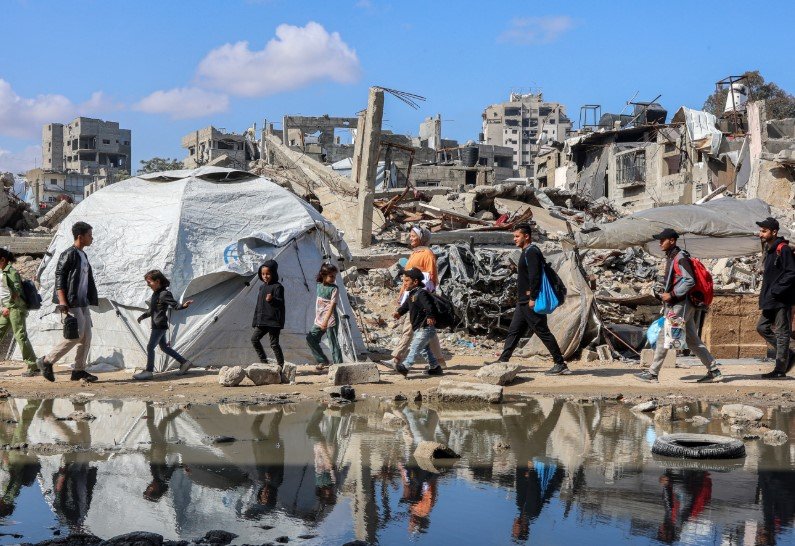Hamas officials are pushing for firm guarantees that Israel will fully withdraw from Gaza and end the ongoing war as part of ceasefire negotiations. These indirect talks, held in Egypt and mediated by the US, Qatar, and Egypt, wrapped up their second day on October 7, 2025, with discussions centered on President Donald Trump’s 20-point peace plan.
Talks Continue Amid Rising Tensions
Negotiators from Hamas and Israel met indirectly in the Egyptian resort of Sharm el-Sheikh, aiming to secure a lasting ceasefire. The discussions come exactly two years after the October 7, 2023, attacks that killed about 1,200 Israelis and led to the capture of over 250 hostages.
President Trump, speaking from the White House on October 7, 2025, expressed optimism, stating there is a real chance for a deal. He urged both sides to move quickly, highlighting the plan’s focus on hostage releases, aid delivery, and reconstruction.
Hamas has shown willingness to engage but insists on clear commitments. A senior official told reporters that the group plans to release captives in phases, tied directly to Israeli troop withdrawals.

The talks have drawn international attention, with senior Qatari and US officials joining on October 8, 2025. German Foreign Minister Annalena Baerbock also planned a visit to Egypt to discuss the negotiations.
Key Demands from Hamas
Hamas seeks an end to the war and a complete Israeli military exit from Gaza. Their position aligns with a broader Palestinian statement rejecting any disarmament without full withdrawal.
The group holds around 48 Israeli captives, with estimates suggesting 20 are still alive. They propose staged releases linked to withdrawal timelines.
Here are the main elements Hamas is demanding:
- Permanent ceasefire with no resumption of hostilities.
- Full withdrawal of Israeli forces from all Gaza areas.
- Unrestricted return of displaced Palestinians to their homes.
- Massive aid influx and reconstruction support over five years.
- Prisoner exchanges, with Israel releasing Palestinian detainees.
These demands contrast with Israel’s red lines, which include maintaining security control and ensuring Hamas cannot rearm.
Recent reports indicate Hamas has made concessions, such as agreeing to step down from governing Gaza and handing control to an independent committee. This could pave the way for a technocratic administration.
Progress and Challenges in Negotiations
The second day of talks on October 7, 2025, saw some progress, but gaps remain. Mediators reported advancements on hostage releases and aid corridors.
Trump’s plan outlines a six-week initial ceasefire, gradual Israeli withdrawal, and the entry of 600 humanitarian trucks daily. It also calls for Hamas to release 33 hostages in the first phase, with Israel freeing terrorists in exchange.
However, the plan is vague on timelines for full withdrawal, leading to Hamas’s call for guarantees. Sources close to the talks say US officials have offered assurances through Qatar for a permanent exit.
Challenges include Israel’s ongoing military operations. On October 3, 2025, Israeli airstrikes targeted Hamas members, complicating the atmosphere.
Palestinian factions issued a joint statement vowing resistance by all means, emphasizing they will not cede weapons without concessions.
A table summarizing the proposed phases of the deal:
| Phase | Duration | Key Actions |
|---|---|---|
| 1 | 6 weeks | Initial ceasefire, release of 33 hostages, entry of 600 aid trucks, partial withdrawal |
| 2 | Ongoing | Staged hostage releases, prisoner exchanges, full withdrawal timelines |
| 3 | 5 years | Reconstruction, aid delivery, establishment of independent governance |
This structure aims to build trust, but both sides must agree on enforcement mechanisms.
Israeli officials have delivered withdrawal maps and timings, signaling potential movement toward a deal.
International Role and Broader Impact
The US, under President Trump, plays a central role, with his plan serving as the framework. Trump has reiterated support for an independent Palestinian state, echoing Russian President Vladimir Putin’s stance in related discussions.
Qatar and Egypt act as key mediators, hosting the talks and facilitating communication. The Qatari prime minister traveled to Egypt to push for agreement.
The war has caused massive destruction in Gaza, with over 40,000 Palestinian deaths reported since 2023. Reconstruction efforts could take years, requiring billions in international funding.
Analysts note that a deal could stabilize the region, reducing risks of escalation with groups like Hezbollah in Lebanon.
Recent events, such as Israel’s September 2025 airstrikes on Hamas leaders in Qatar, highlight the fragility. Yet, Hamas’s reported willingness to disarm under international supervision offers hope.
What Lies Ahead for Gaza Peace
As talks enter their third day on October 8, 2025, the focus shifts to bridging gaps on guarantees. Hamas officials stress that without firm commitments, progress will stall.
Experts believe a successful deal could lead to broader Middle East stability, including normalized relations with Arab states.
The human cost remains high, with families on both sides awaiting news of loved ones. A ceasefire would allow aid to flow freely, addressing the humanitarian crisis.
Share your thoughts on these developments in the comments below, and spread the word by sharing this article with others interested in Middle East peace efforts.
